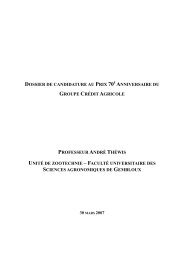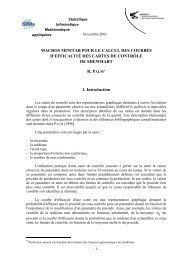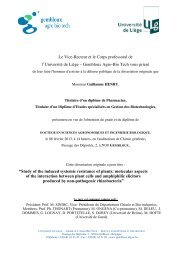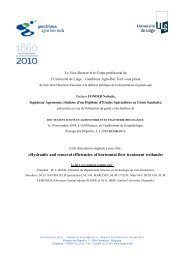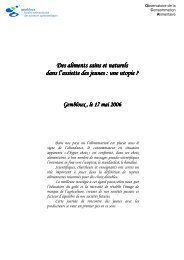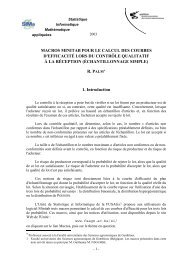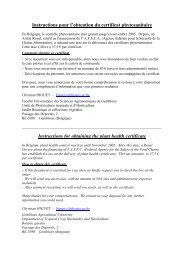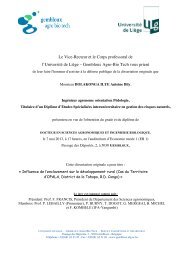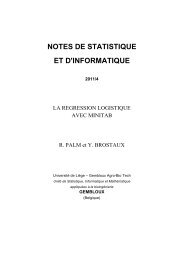3-116 Chapitre 3 Sans BC Billons 2 et 3 Billons 2 et 3 sans BC Covariables Lcern et BC 8 312 8 017 8 286 7 974 1009 1001 900 916 12,0 12,5 10,9 11,5 0,80 0,88 0,69 0,81 (0,41 à 0,90) 0,68 (0,29 à 0,87) 0,79 (0,50 à 0,92) 0,53 (0,07 à 0,81) 0,67 (0,30 à 0,87) 9,7 11,0 7,5 9,2 9948 9840 9678 9360 3.4.2. Conséquences d'une sélection clonale pour le mo<strong>du</strong>le <strong>d'élasticité</strong> 6748 6867 7028 6265 Après avoir montré que le mo<strong>du</strong>le <strong>d'élasticité</strong> <strong>du</strong> <strong>Mélèze</strong> hybri<strong>de</strong> pouvait avantageusement être intégré dans un programme <strong>de</strong> sélection clonale, il y a lieu <strong>de</strong> vérifier que cette stratégie d'amélioration n'a pas d'impact non désiré sur d'autres caractéristiques dont il est reconnu qu'elles sont héritables et qui sont susceptibles d'intéresser les forestiers ou les utilisateurs <strong>du</strong> <strong>bois</strong>. 3.4.2.1. Estimation <strong>de</strong> l'héritabilité génotypique <strong>de</strong>s principales caractéristiques technologiques et <strong>de</strong> croissance. Les caractéristiques retenues tiennent compte <strong>de</strong>s résultats fournis par la littérature. Les paramètres en ont été calculés, suivant les modèles utilisés pour le mo<strong>du</strong>le <strong>d'élasticité</strong>, à partir <strong>de</strong>s données propres à cette expérience et sont résumées dans le tableau 3.4.19. Il se confirme que les principales caractéristiques technologiques mesurées dans ce test sont fortement à très fortement héritables, ce qui justifie l'intérêt d'étudier les corrélations d'ordre génotypique qui peuvent exister avec le mo<strong>du</strong>le <strong>d'élasticité</strong>. Ces résultats sont en conformité avec les données disponibles dans la littérature, quand elles existent. Tableau 3.4.19 Evaluation <strong>de</strong>s contraintes <strong>de</strong> rupture en flexion statique (MOR) et en compression axiale (COMP), <strong>du</strong> <strong>bois</strong> <strong>de</strong> compression (BC), <strong>de</strong> la masse volumique (MV), <strong>de</strong> l'angle <strong>du</strong> fil (Angfil), <strong>du</strong> retrait volumétrique total (RVT), <strong>du</strong> contraste (Contr), <strong>du</strong> nombre <strong>de</strong> cernes d'aubier (NAUB), <strong>de</strong> la forme (F), <strong>de</strong> la
Evaluation <strong>du</strong> mo<strong>du</strong>le <strong>d'élasticité</strong> 3-117 circonférence (C95), <strong>du</strong> volume total (VOLT) et <strong>de</strong> la biomasse (BIOM) <strong>de</strong> la tige mesurés à partir <strong>de</strong> 16 clones représentés par <strong>de</strong>ux ramets, issus <strong>du</strong> test <strong>de</strong> Virton. Détermination <strong>de</strong> différents paramètres génotypiques. Caractéristique Moyenne ETP CVP h²G h²Gi ∆GC (%) MOR (MPa) 70,6 7,8 11,1 0,93 0,87 (0,67 à 0,95) 11,1 COMP (MPa) 38,6 3,2 8,4 0,91 0,84 (0,62 à 0,94) 7,7 BC (Echelle) 1,65 1,1 67,1 0,49 0,33 (-0,17 à 0,70) 33,1 MV (kg/m³) 416 21 5,1 0,91 0,84 (0,61 à 0,94) 4,7 Angfil (°) 3,4 0,83 24,6 0,69 0,53 (0,07 à 0,80) 16,9 RVT (%) 11,7 0,95 8,2 0,86 0,76 (0,45 à 0,91) 7,1 Contr (kg/m³) 630 40,6 6,4 0,70 0,54 (0,10 à 0,81) 4,6 NAUB (-) 5,68 0,45 8,1 0,54 0,36 (-0,14 à 0,71) 4,38 F (Echelle) 2,1 0,45 22,1 0,39 0,24 (-0,26 à 0,65) 8,6 C95 (cm) 62,7 4,6 7,3 0,66 0,49 (0,03 à 0,79) 4,8 VOLT (dm³) 277 51 18,3 0,69 0,53 (0,08 à 0,81) 12,7 BIOM (kg) 91 15,5 17,1 0,60 0,43 (-0,06 à 0,75) 10,2 Max Min 83,0 44,5 3,96 446 5,0 13,8 705 6,22 2,7 71,5 Force est <strong>de</strong> constater qu'à l'exception <strong>de</strong> la masse volumique, pour laquelle plusieurs étu<strong>de</strong>s abordant l'héritabilité au niveau clonal sont disponibles pour le genre <strong>Larix</strong> (SACHSSE et al., 1978; LEWARK, 1980; KOIZUMI et al., 1990a; BASTIEN et al., 2000), très peu d'informations sont fournies dans la littérature sur les autres caractéristiques technologiques. Notons cependant l'article <strong>de</strong> SACHSSE et al. (1978) qui, à partir d'un échantillon constitué <strong>de</strong> 22 clones <strong>de</strong> <strong>Mélèze</strong> <strong>du</strong> Japon, fait état d'un effet très hautement significatif <strong>du</strong> facteur "clone" pour le mo<strong>du</strong>le <strong>de</strong> rupture. Pour l'importance <strong>du</strong> <strong>du</strong>ramen, SACHSSE et al. (1978) ont observé un effet clonal en <strong>Mélèze</strong> <strong>du</strong> Japon. De même, PAQUES (2001) a obtenu une héritablilité génotypique élevée (h²Gi = 0,58) pour le nombre <strong>de</strong> cernes <strong>de</strong> l'aubier <strong>du</strong> <strong>Mélèze</strong> hybri<strong>de</strong> dans un test <strong>de</strong> clones. 382 62 58,6 34,7 0,35 383 2,0 10,6 572 4,72 1,4 54,0 184 125
- Page 1 and 2:
COMMUNAUTE FRANCAISE DE BELGIQUE FA
- Page 3 and 4:
JACQUES Dominique. (2003). Amélior
- Page 5 and 6:
Remerciements C'est avec un plaisir
- Page 7 and 8:
Chapitre 5. Stabilité clonale de l
- Page 9 and 10:
Chapitre 1. Le Mélèze en Région
- Page 11 and 12:
Le Mélèze en Région wallonne 1-7
- Page 13 and 14:
Le Mélèze en Région wallonne 1-9
- Page 15 and 16:
Le Mélèze en Région wallonne 1-1
- Page 17 and 18:
Le Mélèze en Région wallonne 1-1
- Page 19 and 20:
Mélèze du Japon Mélèze d'Europe
- Page 21 and 22:
Le Mélèze en Région wallonne 1-1
- Page 23 and 24:
Le Mélèze en Région wallonne 1-1
- Page 25 and 26:
Le Mélèze en Région wallonne 1-2
- Page 27 and 28:
1.5. Perspectives Le Mélèze en R
- Page 29 and 30:
2-26 Chapitre 2 et HAINES, 1999). E
- Page 31 and 32:
2-28 Chapitre 2 - l'angle plus pron
- Page 33 and 34:
2-30 Chapitre 2 Sa présence est so
- Page 35 and 36:
2-32 Chapitre 2 Dans le cas d'une u
- Page 37 and 38:
2-34 Chapitre 2 échantillons les p
- Page 39 and 40:
2 3 2-36 Chapitre 2 PAQUES, 1996a R
- Page 41 and 42:
2-38 Chapitre 2 Sur Epicéa commun,
- Page 43 and 44:
2-40 Chapitre 2 corrélations posit
- Page 45 and 46:
2-42 Chapitre 2 Chez l'Epicéa comm
- Page 47 and 48:
2-44 Chapitre 2 constaté que cette
- Page 49 and 50:
2-46 Chapitre 2 Sur 60 arbres d'Epi
- Page 51 and 52:
2-48 Chapitre 2 en traction, a ét
- Page 53 and 54:
2-50 Chapitre 2 de corrélation tr
- Page 55 and 56:
2-52 Chapitre 2 Cette méthode n'es
- Page 57 and 58:
2-54 Chapitre 2 permet en outre d'
- Page 59 and 60:
2-56 Chapitre 2 2° Torsiomètre Le
- Page 61 and 62:
2-58 Chapitre 2 P P P Figure 2.2.1
- Page 63 and 64:
2-60 Chapitre 2 où ix = différent
- Page 65 and 66:
2-62 Chapitre 2 élaborée causant
- Page 67 and 68: 2-64 Chapitre 2 densité; elles son
- Page 69 and 70: 2-66 Chapitre 2 A côté des nombre
- Page 71 and 72: 2-68 Chapitre 2 des niveaux de liai
- Page 73 and 74: Chapitre 3. Sélection clonale dire
- Page 75 and 76: Evaluation du module d'élasticité
- Page 77 and 78: Evaluation du module d'élasticité
- Page 79 and 80: Evaluation du module d'élasticité
- Page 81 and 82: Il se calcule comme suit: Evaluatio
- Page 83 and 84: Evaluation du module d'élasticité
- Page 85 and 86: Evaluation du module d'élasticité
- Page 87 and 88: Evaluation du module d'élasticité
- Page 89 and 90: Evaluation du module d'élasticité
- Page 91 and 92: Evaluation du module d'élasticité
- Page 93 and 94: Evaluation du module d'élasticité
- Page 95 and 96: Evaluation du module d'élasticité
- Page 97 and 98: Evaluation du module d'élasticité
- Page 99 and 100: Evaluation du module d'élasticité
- Page 101 and 102: Evaluation du module d'élasticité
- Page 103 and 104: Evaluation du module d'élasticité
- Page 105 and 106: Evaluation du module d'élasticité
- Page 107 and 108: Evaluation du module d'élasticité
- Page 109 and 110: Evaluation du module d'élasticité
- Page 111 and 112: Evaluation du module d'élasticité
- Page 113 and 114: Evaluation du module d'élasticité
- Page 115 and 116: Evaluation du module d'élasticité
- Page 117: Evaluation du module d'élasticité
- Page 121 and 122: Evaluation du module d'élasticité
- Page 123 and 124: Evaluation du module d'élasticité
- Page 125 and 126: Evaluation du module d'élasticité
- Page 127 and 128: Evaluation du module d'élasticité
- Page 129 and 130: Evaluation du module d'élasticité
- Page 131 and 132: Evaluation du module d'élasticité
- Page 133 and 134: Evaluation du module d'élasticité
- Page 135 and 136: Evaluation du module d'élasticité
- Page 137 and 138: Modlule d'élasticité (MPa) 10000
- Page 139 and 140: Evaluation du module d'élasticité
- Page 141 and 142: Evaluation du module d'élasticité
- Page 143 and 144: Evaluation du module d'élasticité
- Page 145 and 146: Evaluation du module d'élasticité
- Page 147 and 148: Evaluation du module d'élasticité
- Page 149 and 150: Evaluation du module d'élasticité
- Page 151 and 152: Evaluation du module d'élasticité
- Page 153 and 154: Evaluation du module d'élasticité
- Page 155 and 156: Chapitre 4. Evaluation de l'influen
- Page 157 and 158: Densité du bois en pépinière 4-1
- Page 159 and 160: Densité du bois en pépinière 4-1
- Page 161 and 162: Densité du bois en pépinière 4-1
- Page 163 and 164: Densité du bois en pépinière 4-1
- Page 165 and 166: Densité du bois en pépinière 4-1
- Page 167 and 168: Densité du bois en pépinière 4-1
- Page 169 and 170:
Densité du bois en pépinière 4-1
- Page 171 and 172:
Densité du bois en pépinière 4-1
- Page 173 and 174:
Héritabilité génotypique Densit
- Page 175 and 176:
Densité du bois en pépinière 4-1
- Page 177 and 178:
Densité du bois en pépinière 4-1
- Page 179 and 180:
Chapitre 5. Stabilité clonale de l
- Page 181 and 182:
Interactions "Clone x Environnement
- Page 183 and 184:
Interactions "Clone x Environnement
- Page 185 and 186:
Interactions "Clone x Environnement
- Page 187 and 188:
Interactions "Clone x Environnement
- Page 189 and 190:
5.2.2.2. Matériel et méthodes Int
- Page 191 and 192:
Interactions "Clone x Environnement
- Page 193 and 194:
Interactions "Clone x Environnement
- Page 195 and 196:
Interactions "Clone x Environnement
- Page 197 and 198:
Interactions "Clone x Environnement
- Page 199 and 200:
Interactions "Clone x Environnement
- Page 201 and 202:
Largeur de cerne moyenne pour la p
- Page 203 and 204:
Interactions "Clone x Environnement
- Page 205 and 206:
2. Mesure au Sylvatest Interactions
- Page 207 and 208:
Interactions "Clone x Environnement
- Page 209 and 210:
Interactions "Clone x Environnement
- Page 211 and 212:
AAMH (Baileux / Bellefontaine) AAMH
- Page 213 and 214:
Interactions "Clone x Environnement
- Page 215 and 216:
Interactions "Clone x Environnement
- Page 217 and 218:
Interactions "Clone x Environnement
- Page 219 and 220:
Interactions "Clone x Environnement
- Page 221 and 222:
Interactions "Clone x Environnement
- Page 223 and 224:
Interactions "Clone x Environnement
- Page 225 and 226:
Interactions "Clone x Environnement
- Page 227 and 228:
Interactions "Clone x Environnement
- Page 229 and 230:
6-228 Chapitre 6 génotypiques lian
- Page 231 and 232:
6-230 Chapitre 6 Ajoutons enfin que
- Page 233 and 234:
6-232 Chapitre 6 Les mesures réali
- Page 235 and 236:
6-234 Chapitre 6 La masse volumique
- Page 237 and 238:
6-236 Chapitre 6 les mesures d'infr
- Page 239 and 240:
6-238 Chapitre 6 6.3. Impact de la
- Page 241 and 242:
6-240 Chapitre 6 Dans l'hypothèse
- Page 243 and 244:
6-242 Chapitre 6 6.4.1.1. Types de
- Page 245 and 246:
6-244 Chapitre 6 Si ces conditions
- Page 247 and 248:
6-246 Chapitre 6 Si la parcelle est
- Page 249 and 250:
6-248 Chapitre 6 4° Choix du nombr
- Page 251 and 252:
6-250 Chapitre 6 Les résultats des
- Page 253 and 254:
6-252 Chapitre 6 Héritabilité 1.0
- Page 255 and 256:
6-254 Chapitre 6 limiter au maximum
- Page 257 and 258:
6-256 Chapitre 6 hauteur), pemet au
- Page 259 and 260:
6-258 Chapitre 6 principalement les
- Page 261 and 262:
6-260 Chapitre 6 6.7. Perspectives
- Page 263 and 264:
6-262 Chapitre 6 espèce présente
- Page 265 and 266:
264 La vitesse ultrasonore, mesur
- Page 267 and 268:
Références bibliographiques AFNOR
- Page 269 and 270:
269 BRAZIER, J.D. (1967) - Timber i
- Page 271 and 272:
271 DADSWELL, H.E. (1960) - Tree gr
- Page 273 and 274:
273 EINSPAHR, D.W.; VAN BUIJTENEN,
- Page 275 and 276:
275 GOBELET d’ALVIELLA (1927) - H
- Page 277 and 278:
277 JENSEN, G. (1994) - Modelling s
- Page 279 and 280:
279 LARSEN, A.B.; WELLENDORF, H.; R
- Page 281 and 282:
281 hybride (Larix x eurolepis Henr
- Page 283 and 284:
283 NANSON, A. (1981) - Comment acc
- Page 285 and 286:
285 OLESEN, P.O. (1982) - The effec
- Page 287 and 288:
287 PLOMION, C.; DUREL, C.E.; VERHA
- Page 289 and 290:
289 RUSSEL, J.H.; LOO-DINKINS, J.A.
- Page 291 and 292:
291 TAKATA, K.; KOIZUMI, A.; UEDA,
- Page 293:
293 WIMMER, R. (1995) - Intra-annua



